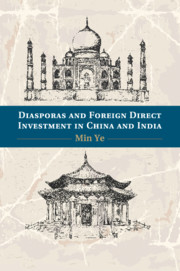Crossref Citations
This Book has been
cited by the following publications. This list is generated based on data provided by Crossref.
Contractor, Farok J.
Kumar, Vikas
and
Dhanaraj, Charles
2015.
Leveraging India: Global Interconnectedness and Locational Competitive Advantage.
Management International Review,
Vol. 55,
Issue. 2,
p.
159.
2015.
Books Received.
The China Quarterly,
Vol. 221,
Issue. ,
p.
290.
Tsai, Kellee S.
2016.
Cosmopolitan Capitalism: Local State-Society Relations in China and India.
The Journal of Asian Studies,
Vol. 75,
Issue. 2,
p.
335.
Petroff, Alisa
2016.
Reversing the brain drain: evidence from a Romanian brain networking organization.
International Migration,
Vol. 54,
Issue. 5,
p.
122.
Pandya, Sonal S.
2016.
Political Economy of Foreign Direct Investment: Globalized Production in the Twenty-First Century.
Annual Review of Political Science,
Vol. 19,
Issue. 1,
p.
455.
Ye, Min
2016.
UTILITY AND CONDITIONS OF DIFFUSION BY DIASPORAS: EXAMINING FOREIGN DIRECT INVESTMENT LIBERALIZATION IN CHINA AND INDIA.
Journal of East Asian Studies,
Vol. 16,
Issue. 2,
p.
261.
Kan, Karita
2017.
The (geo)politics of land and foreign real estate investment in China: the case of Hong Kong FDI.
International Journal of Housing Policy,
Vol. 17,
Issue. 1,
p.
35.
Agnihotri, Arpita
and
Bhattacharya, Saurabh
2018.
International acquisitions and emerging market firms' performance—a structural contingency perspective.
Thunderbird International Business Review,
Vol. 60,
Issue. 4,
p.
691.
van Dongen, Els
2018.
Looking to China and Back.
China Report,
Vol. 54,
Issue. 2,
p.
231.
Zheng, Yongnian
and
Huang, Yanjie
2018.
Market in State.
Kim, Hyejin
2018.
Transnational Korean Networks and Business in China.
Europe-Asia Studies,
Vol. 70,
Issue. 7,
p.
1143.
Frazier, Mark W.
2019.
The Power of Place.
Marks, Stephen V.
and
Yau, Cheryl Jia Min
2019.
Southeast Asia and the ASEAN Economic Community.
p.
381.
Ho, Selina
2019.
Thirsty Cities.
Ye, Min
2020.
The Belt Road and Beyond.
Ye, Min
2020.
The Power of Place: Contentious Politics in Twentieth-Century Shanghai and Bombay. By Mark W. Frazier. Cambridge: Cambridge University Press, 2019. 296 pp. ISBN: 9781108722193 (paper)..
The Journal of Asian Studies,
Vol. 79,
Issue. 3,
p.
793.
Liu, Jiaqi M.
2021.
Citizenship on the move: the deprivation and restoration of emigrants’hukouin China.
Journal of Ethnic and Migration Studies,
Vol. 47,
Issue. 3,
p.
557.
DAS, KHANINDRA CH.
2021.
INDIAN INVESTMENT IN CHINESE PROVINCES: SPATIAL DISTRIBUTION, LOCATIONAL DETERMINANTS, CHALLENGES AND IMPLICATIONS.
The Singapore Economic Review,
Vol. 66,
Issue. 03,
p.
767.
Ye, Min
2021.
FRAGMENTED MOTIVES AND POLICIES: THE BELT AND ROAD INITIATIVE IN CHINA.
Journal of East Asian Studies,
Vol. 21,
Issue. 2,
p.
193.
Nachiappan, Karthik
2022.
India and the framework convention on tobacco control: the politics of rising power attitudes toward international rules.
Contemporary South Asia,
Vol. 30,
Issue. 2,
p.
253.



